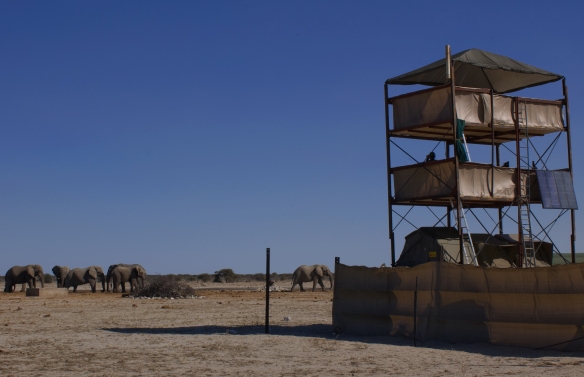
Caitlin O’Connell-Rodwell in Etosha National Park.
Photograph by Tim Rodwell.
When it’s time to leave the waterhole, African elephant family groups have a special way of announcing their departure. “We call it the ‘let’s go’ rumble,” explains Caitlin O’Connell-Rodwell, a Stanford University scientist who has been studying elephants in Namibia’s Etosha National Park for 20 years. First comes the low-frequency call of the matriarch, followed by a series of close or overlapping rumbles from other high-ranking females. “What you get is a call that’s at least three times the size of the original call,” O’Connell-Rodwell says. “It’s as if they need the motivation of this call to action.” Her study of these departure vocalizations recently appeared in the journal Bioacoustics.
But the scope of O’Connell-Rodwell’s research is larger (one might say elephantine): Her interests extend from seismic communication to wildlife conservation to the effects of the environment on elephants’ social structure. “There are a lot of different questions we have, because elephants are long-lived social animals,” she says. “It takes years to find particular social patterns.” Hoping to learn as much as possible about the elephants without disturbing them, O’Connell-Rodwell and her colleagues have set up a solar-powered camp at Mushara waterhole.
O’Connell-Rodwell is also co-founder of Utopia Scientific, a nonprofit research and education organization, as well as the author of three books, including The Elephant’s Secret Sense: The Hidden Life of the Wild Herds of Africa. Here are a few glimpses of her work among the elephants of southern Africa:
You Talking to Me?
The waterhole is a great place to see the social behavior of elephants, as shown in another recent study by O’Connell-Rodwell in Ethology, Ecology, and Evolution. In a dry year, male elephants appear to know their place in the social order, following a kind of water-hole etiquette. “A lower-ranking elephant will typically stick his trunk inside the dominant bull’s mouth, and then step away as if to say, ‘I’m just going to drink over here where it’s really salty,’” O’Connell-Rodwell says. (“Elephants use their trunks like people use handshakes–as a greeting, a sign of respect, or appeasement.”)
Studying waterhole behavior, O’Connell-Rodwell found that elephants form linear dominance hierarchies in years with low rainfall. “When there are minimal resources, you have to have more order to prevent chaos,” she says. “Everyone knows where they stand, so there is less fighting and less stress.” Acts of affiliation, like the trunk-in-mouth described above, are more common than aggression.
But during wet years, things can get a little surly. O’Connell found younger bulls to be more aggressive than affiliative. (Aggressive behaviors can include anything from charging another elephant to flaring the ears.) “You don’t need to kowtow to the dominant [bull] when you can drink anywhere,” she says. “There is a lot more aggression when there is uncertainty in the ranking.”
Bulls in a Rush
When male elephants break out of the protected borders of the Etosha National Park, they often wind up in places where they’re unwanted. This puts them at risk of getting shot by humans. Concerned about the conservation of this sensitive species, O’Connell-Rodwell has experimented with one promising way of getting bulls to return: broadcasting a recording of an estrus call.
Female elephants ovulate only four days in a five-year period. As a result, an estrus call is attended with great interest. “The [male] elephants turn on a dime and go straight to the source.”
Click here to watch a video of a bull responding with impressive urgency to an estrus-call playback.
Long-Distance Calling
Elephants don’t just “feel the earth move” under their fleshy footpads. They can detect and interpret vibrations made by the faraway calls of other elephants. O’Connell-Rodwell was the first scientist to document this more than a decade ago. (See her article in Physiology for a more recent review of seismic communication among African and Asian elephants.)
Having previously studied seismic communication in insects, O’Connell-Rodwell became aware that elephants were doing similar things to gather information: leaning forward, freezing in mid-stride, and sometimes lifting a foot off the ground. “It took about 10 years to prove that was happening.”
As her article explains, elephants produce powerful, low frequency vocalizations that “couple with the ground and travel along the surface of the earth with a separate velocity than their airborne counterparts.” Several aspects of elephants’ anatomy, from their fat-covered feet to the sinuses in their skulls, may help them detect these vibrations. They also seem able to discriminate between different seismic signals, responding with greater vigilance to alarm calls from familiar elephants.
Based on what she’s learned from elephant communication, O’Connell-Rodwell is working to develop a vibrotactile hearing aid for humans.
Going solar
Elephants may stomp around, but they are easily disturbed by human activity. This past summer, O’Connell-Rodwell and her colleagues set up a solar-powered research camp at the Mushara waterhole, enabling them to study and videotape the elephants unobtrusively.
“Most documentarians who go to remote places are just accustomed to plugging a generator in,” she says. “It destroys the environment, and elephants wouldn’t want to come [near] with such noisy situations. It was great to do this whole documentary as well as our research with a couple of solar panels.”
O’Connell-Rodwell continues to look for other ways to collect data about elephants. She hopes to find funding for additional projects, such as setting up sensors in the ground to track elephants based on their footfall patterns. “There are not many of them left,” she says, “so people want to monitor them more closely.”


